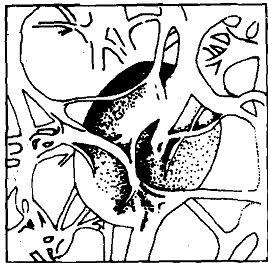Haemostatic Mechanisms - Circulation
When we accidently get hurt or cut our finger, blood starts flowing but within a few minutes it stops flowing too. Several mechanisms help prevent loss of blood from ruptured blood vessels. Damaged blood vessels constrict and so decrease the blood flow; but the most important mechanism,-however, is the closing of the blood vessel at the site of the injury by formation of a plug or clot which involves the conversion of liquid blood to jelly which prevents further escape of blood. The clotting mechanism or coagulation has been well studied in mammals especially man, as it is of great medical importance.

Figure: Human RBC caught in a mesh of fibrin
Let us try to understand the process. When a section of a blood clot is examined under a microscope, it is found to be composed of a tangled mesh of very delicate fibrils among which are entrapped, as in a net, erythrocytes, leucocytes, and many fragmented platelets. The filaments are composed of fibrin, an insoluble gel form of the protein fibrinogen which is present in the plasma. These filaments may be seen in many places to radiate from centers formed of platelets. If the clot is allowed to stand for a while, it undergoes shrinkage, and as it shrinks, expresses from its meshes a clear, faintly straw coloured fluid, the serum. The serum remains fluid indefinitely; it is quite incapable of clotting, for it contains no fibrinogen. Plasma separated from the blood cells by centrifuging, clots in a way similar to that of whole blood and expresses the clear serum. The clot (coagulation) is white, since it contains no cells, but except for this difference it is identical with that formed in whole blood. The clotting process is essentially, therefore, a phenomenon of the plasma. Lymph also clots, though somewhat more slowly and less firmly than does blood or plasma.